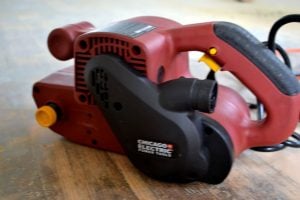[AdSense-A]Sanding hardwood floors is one of those DIY projects that takes a great deal of patience and precision, but when it’s all said and done it’s one of the most rewarding. Refinishing floors to bring back that same great look isn’t exactly an overnight job as you can expect to spend a great deal of time while putting in the effort to revitalize your house. Hardwood floors are one of those home accents that truly transforms the entire look, and can give you entire home a new sense of purpose.
Sanding hardwood floors can be difficult, but when you understand what and how it’s done it’s much easier than most would tell you. Aside from the typical gratification of a DIY project gone right, it saves you a great deal of money while allowing you to create your very own look.
Below, we have detailed some tips and tricks from the pros which will help you while sanding hardwood floors with a  belt sander.
belt sander.
Look at Buying Instead of Renting a Belt Sander
Unlike drum sanders, I would recommend buying a belt sander instead of renting if you’re intending on sanding your hardwood floors. Belt sanders serve many purposes that goes well beyond floor finishing as it can easily become one of the most used tools in the shed. Belt sanders are very versatile and is relatively cheap when comparing it to other DIY tools.
In many cases, you will get your money back on a belt sander after 3 rentals, but you can expect to use it may times more. If you do choose to buy, there are numerous to choose from so understanding which are the top belt sanders for the specific task your looking for will be paramount.
Don’t Cut Corners to Save a Buck
We’ve all heard of the saying you “pay for what you get”, and the same is true with DIY home projects. It is so easy to cut corners here and there thinking that saving money on such items as sandpaper will save you money when it’s all said and done. Sandpaper is one of those items we wouldn’t recommend cutting corners on as it’s always better to spend a bit extra to get a job well done. The quality of the sandpaper is extremely important as I would always look for buying 3M premium sandpaper.
Choose a Sander with Automatic Tracking Functionality
Some belt sanders have automatic tracking functionality, and this is one of the best features. Auto tracking alleviates having to adjust and readjust the belt which can become one of the biggest problems while using a belt sander. Without auto tracking, you’ll have to make sure the belt is, and remains aligned on the center of the sanding drum, and with the auto tracking feature it’s a non-issue.
Sand First in a Closest or Obscure Location
Sanding hardwood floors isn’t for everyone as it’s easily one of the most physical and difficult DIY projects. To determine not only if it’s right for you, but to make sure your using a good sander and sandpaper start off in a closet or other obscure, or less visible location. If you have undesirable results, it’s much easier to overlook if you don’t see it.
Use a Belt Sander in Conjunction with a Planetary Sander
Belt sanders are extremely aggressive which will serve its purpose with sanding hardwood floors. Using this type of sander alone may not be the best option, but it’ll definitely be your first option. Use a belt sander in conjunction with a planetary sander such as an orbital sander will give you the best finish. The aggressive nature of the belt sander is great for the initial re-purpose as well as stripping old stock, but a less aggressive planetary sander is best for the finishing touches.
Make Sure the Belt Orientation is the Right Direction
Most sanding belts have directional arrows which are used for installation. Make sure the arrows are installed in the same direction as the motion of the drum. Other belts, or non-directional belts can be installed either way and will function the same.
Attach a Hose to the Dust Collection Bag
Virtually all belt sanders come equipped with a dust collection bag that entraps a majority of the sanding dust. Taking it one step further, you’ll want to attach a hose to the bag system which will vacuum, and collect the smaller, residual sanding dust which inevitably free-flows within the air. There are specific dust collection hoses which will affix to the bag system which will virtually eliminate any visible sanding dust.
The hose/vacuum system is relatively cheap and can be found on Amazon for under $25. Be sure to consult your specific model, and for those who are a bit more creative, something can easily be crafted using a shop vac and duct tape.
Understand that Throwing in the Towel Isn’t Always a Bad Thing
Sanding hardwood floors is a very difficult and time consuming DIY project, and understanding that it may be too much isn’t a bad thing. I can’t tell you how many times I have seen people get so frustrated in the job itself, remain so persistent, and absolutely refuse to throw in the towel. Inevitably, something bad happens and undesirable blemishes
If you get to a point where it really seems to be too much, turning on your computer and looking for a professional will never be a bad thing. Once you’re done, it will be time to stain the hardwood floors to get that amazing, and truly finished look. Checking out these tips and tricks from the pros will make the entire project much easier than you think.
[AdSense-A]





